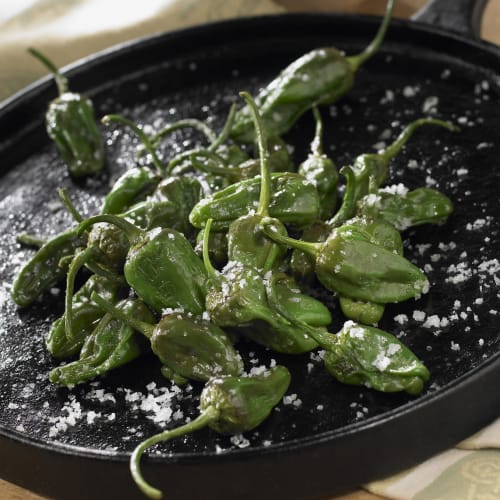The Legend of Padrón
August 2007




The contemporary culture seems to be very receptive to fantasy and legend. There is great interest in the legend of the Holy Grail or Tolkien’s Middle Earth, C.S. Lewis’s Narnia and now the finale of the Harry Potter series. The latest and greatest rollercoaster at Busch Gardens is named after a mythological beast, the Gryphon.
I wonder how many of you realize that the wonderful little Pimientos de Padrón, which are a surprise hit here at La Tienda, are also wrapped in legend! Although there is no parallel with the enthusiasm about Harry Potter, each year we ask our local farmer to plant a few more rows of seedlings – and now we have asked another farmer to lend a hand as well.
The origin of the seeds from which we grow these delightful peppers in Virginia trace back to a rustic town along the Atlantic coast of Galicia, in farthest Northwest Spain. The town of Padrón is so far west that the neighboring village on the storm-tossed Atlantic Coast is called Finisterre - loosely translated as “the end of the world.”
The town of Padrón is shrouded in history and legend that stretch back to pre-history. Archaeologists tell us that it was an Iberian settlement of the Caporos people. Because of its natural location at the confluence of two rivers, the settlement was on the crossroads to what is now Braga (Portugal) to the south and Astorga (León) to the east. Classical Roman documents indicate that it became a significant town named Iria Flavia under the Romans.
Now here is where the need to sort out history and legend comes into play. According to tradition, it was in a rocky area above Iria Flavia that Apostle Saint James first preached during his stay in Hispania, which was at the peak of its cultural ascendancy in the Roman Empire, so it is conceivable that James would head there, as had St Paul, according to Biblical accounts.
Unfortunately he returned to the Holy Land where he was martyred in Jerusalem. His disciples Theodore and Athanasius placed the body of James in a stone boat and set it sail westward. They navigated the mythical stone craft across the expanse of the Mediterranean Sea, sailed by Gibraltar through the Pillars of Hercules, and headed north along the Iberian coast until they found safe haven in a peaceful ria or fjord. There they moored their stone vessel to a pedrón (Spanish for big stone).
The two disciples remained in Iria Flavia (now Padrón – Patron ) to preach after burying the body of the apostle in Compostela. The legendary pedrón mooring stone can be seen today at the parish church of Santiago de Padrón.
Legend has it that some shepherds in a field saw a star shining on the site of St James grave in Compostela. It was during the final throes of the struggle against the invading Moors in the eighth century. As news of the shepherd’s miraculous discovery spread to the defending armies they took heart, and at the critical battle of Covadonga they saw St. James riding out of heaven on a splendid white charger in order to lead the Spaniards to victory.
From that time forward, St James (Iago was the old spelling) was viewed as the patron saint of Spain, and the name of the site where the funerial stone boat was pulled ashore was transmuted from “Pedrón (mooring stone) to Padrón (Patron).
Padrón soon became a popular passing place in the Camino de Santiago pilgrimage route but the focus of attention gradually moved to nearby Compostela, capital of Galicia. But here is where the peppers come in (you thought I had forgotten).
Over the years a Franciscan monastery grew up in the barrio of Harbón, a neighborhood of Padrón. It was there at the Herbón monastery where the Franciscans apparently first tried growing the pepper seeds they had brought back from the New World in the 18th century. This place still remains the heart of the Pimientos de Padrón belt today.
One of the members of the La Tienda community wrote me “I am actually from Padrón - my family originates from there. We have a 100-year-old farmhouse next to the monastery in 'Herbon' the small village contained in Padrón. All my aunties and uncles produce these pimientos. There is also an annual 'fiesta' to celebrate the pimiento. People come from all around to visit.”
What do these legends and fantasies have to do with the very tasty and occasionally hot tiny green peppers? Had the Spaniards not believed the legend of Santiago, they might easily have lost the crucial Battle of Covadonga to the surging invaders. Hispania would have had a radically different culture, in which Franciscans could not flourish, nor could they plant peppers in their monasteries. Nor would there be the pilgrims of Santiago de Compostela to enjoy them in their tapas bars and therefore the fame of the peppers would never have spread across Spain and the world.
Are these stories true? Could a stone ship sail across the Mediterranean? Was the body the shepherds found really that of St James or just another first century Roman? How could the soldiers have seen James riding out of heaven on a white horse? These are questions that we as benighted children of the scientific age ask. Certainly they would not have occurred to a medieval pilgrim. For him, life was a mystery.
So when next you sauté in olive oil your portion of these unique peppers from Galicia, and when you dust them with sea salt, before popping them into your mouth as a delightful tapa, be thankful for those whose trusting naivete has enabled you to savor a unique treat from far western Spain.
Tu amigo,
Don

